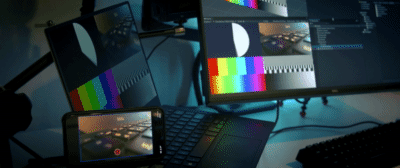KlakNDI is a Unity plugin that allows for sending and receiving video streams between multiple devices using NDI®.
NDI® (Network Device Interface) is a standard developed by Vizrt that enables applications to deliver video streams over a local area network. Please refer to ndi.video for more information about the technology.
- Unity 2022.3 or later
Desktop platforms:
- Windows: x64, D3D11/D3D12
- macOS: x64 or arm64 (M1), Metal
- Linux: x64, Vulkan
Mobile platforms:
- iOS: arm64, Metal
- Android: arm64, Vulkan/OpenGL ES 3.x
KlakNDI runs without the NDI SDK on most supported platforms, but the iOS platform requires the SDK for building with Xcode. Please download and install the NDI SDK for iOS in advance of building.
KlakNDI requires network permissions on Android. Please follow the instruction in Android Support section.
The NDI library files are provided under the terms of the NDI SDK license. Please review it before using the package in your project.
-
Dimensions of frame images should be multiples of 16x8. This limitation causes glitches on several mobile devices when using the Game View capture method.
-
KlakNDI doesn't support audio streaming. There are several technical difficulties to implement without perceptible noise or delay, so there are no plans to implement it.
This package uses the scoped registry feature to resolve package dependencies. Open the Package Manager page in the Project Settings window and add the following entry to the Scoped Registries list:
- Name:
Keijiro - URL:
https://registry.npmjs.com - Scope:
jp.keijiro
Now you can install the package from My Registries page in the Package Manager window.
The NDI Sender component (NdiSender) sends a video stream from a given
video source.
NDI Name - Specify the name of the NDI endpoint (only available in the Camera/Texture capture method).
Keep Alpha - Enable this checkbox to make the stream contain the alpha channel. You can disable it to reduce the bandwidth.
Capture Method - Specify how to capture the video source from the following options:
- Game View - The sender captures frames from the Game View.
- Camera - The sender captures frames from a given camera. This method only supports URP and HDRP.
- Texture - The sender captures frames from a texture asset. You can also use a render texture with this option.
You can attach metadata using the C# .metadata property.
The NDI Receiver component (NdiReceiver) receives a video stream and
feeds it to a renderer object or a render texture asset.
NDI Name - Specify the name of the NDI source. You can edit the text field or use the selector to choose a name from currently available NDI sources.
Target Texture - The receiver copies the received frames into this render texture asset.
Target Renderer - The receiver overrides a texture property of the given renderer.
You can extract metadata using the C# .metadata property.
You can enumerate currently available NDI sources using the NDI Finder class
(NdiFinder). See the Source Selector example for usage.
You can instantiate the NDI Sender/Receiver component from a script but at
the same time, you have to set an NDI Resources asset (NdiResources.asset).
See the Sender Benchmark/Receiver Benchmark examples for details.
KlakNDI requires the following permissions when running on Android:
android.permission.INTERNETandroid.permission.ACCESS_NETWORK_STATEandroid.permission.CHANGE_WIFI_MULTICAST_STATE
You can add them by overriding the App Manifest. Please refer to the AndroidManifest file contained in the URP sample.




